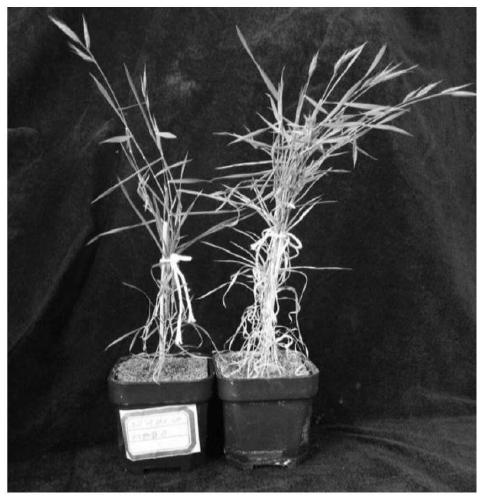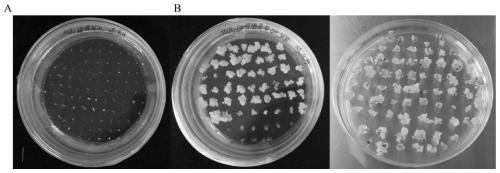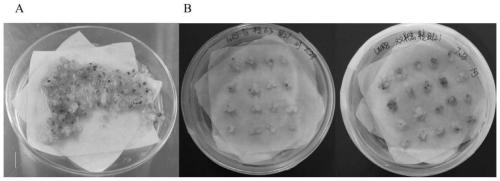Genetic transformation method of brachypodium distachyon
A genetic transformation method, the technology of Brachypodium distachyda, applied in the biological field, can solve the problems of difficult differentiation process, easy pollution, low induction rate, etc., and achieve the effect of improving the regeneration rate
- Summary
- Abstract
- Description
- Claims
- Application Information
AI Technical Summary
Problems solved by technology
Method used
Image
Examples
Embodiment 1
[0106] Example 1: Establishment of a high-efficiency genetic transformation system for immature embryos of Brachypodium distachyda mediated by Agrobacterium
[0107] 1) Material cultivation:
[0108] The material used in this experiment was wild-type Brachypodium distachyon (Bd21 ecotype). The growth conditions are: long-day conditions (18h light / 6h darkness, temperature 20°C), short-day conditions (10h light / 14h darkness, temperature 20°C). In order to promote the simultaneous germination of Brachypodium distachyon, the seeds were vernalized at 4°C for 1 week before sowing. In order to promote the flowering of Brachypodium distachyon in the greenhouse, after the seeds were grown in pots for 2 weeks, they were placed at 4°C for 3 weeks. No significant difference was found between the two types of plants (see figure 1 ).
[0109] 2) The configuration of various culture media of the present invention and other reagents used:
[0110] a. Induction medium (MSB3) medium: MS sa...
Embodiment 2
[0136] Example 2: Effects of different concentrations of 2,4-D on the embryogenic callus rate of Brachypodium distachyon
[0137] 1) Material: 8-12 immature embryos of Brachypodium tachycarpa plants.
[0138] 2) Training method:
[0139] Put the immature embryos of Brachypodium distachyon on the 2,4-D MSB3 medium containing 2.0mg / L, 2.5mg / L, 3.0mg / L, and count the embryogenic callus induction rate (embryogenic callus Rate=number of embryogenic callus / number of inoculated embryos×100%), the results are shown in Table 1. 2,4-D is a kind of auxin analogue, which has the effect of promoting plant growth. There are obvious differences in the embryogenic callus rate and adventitious bud regeneration rate induced by different concentrations. When 2.5mg / L of 2,4-D was used to induce callus, the rate of embryogenic callus was the highest. When the concentration of 2,4-D was reduced to 2.0mg / L or increased to 3.0mg / L, the rate decreased. According to the results in Table 1, it shows...
Embodiment 3
[0142] Embodiment 3: the influence of different concentrations of KT on the regeneration rate of Brachypodium distachydium adventitious buds
[0143] 1) Material: transgenic Brachypodium distachyon callus after one month of screening.
[0144] 2) Training method:
[0145] The transgenic calli after one month of screening were respectively transferred to the regeneration medium containing 0.1mg / L, 0.2mg / L, and 0.3mg / L concentration of KT for differentiation culture, and the statistical results of the adventitious bud regeneration rate are shown in Table 2 (Regeneration rate of adventitious buds=number of regenerated adventitious buds / number of inoculated calluses×100%). The present invention finds that with the increase of KT concentration, the average regeneration rate of adventitious buds first increases and then decreases. When the concentration of KT was 0.2mg / L, the regeneration rate of adventitious buds was better than that of the other two concentrations. The different...
PUM
 Login to View More
Login to View More Abstract
Description
Claims
Application Information
 Login to View More
Login to View More - R&D
- Intellectual Property
- Life Sciences
- Materials
- Tech Scout
- Unparalleled Data Quality
- Higher Quality Content
- 60% Fewer Hallucinations
Browse by: Latest US Patents, China's latest patents, Technical Efficacy Thesaurus, Application Domain, Technology Topic, Popular Technical Reports.
© 2025 PatSnap. All rights reserved.Legal|Privacy policy|Modern Slavery Act Transparency Statement|Sitemap|About US| Contact US: help@patsnap.com



